The global exhaust heat recovery system market was valued at $16.1 billion in 2021, and is projected to reach $28.7 billion by 2031, growing at a CAGR of 6.1% from 2022 to 2031.
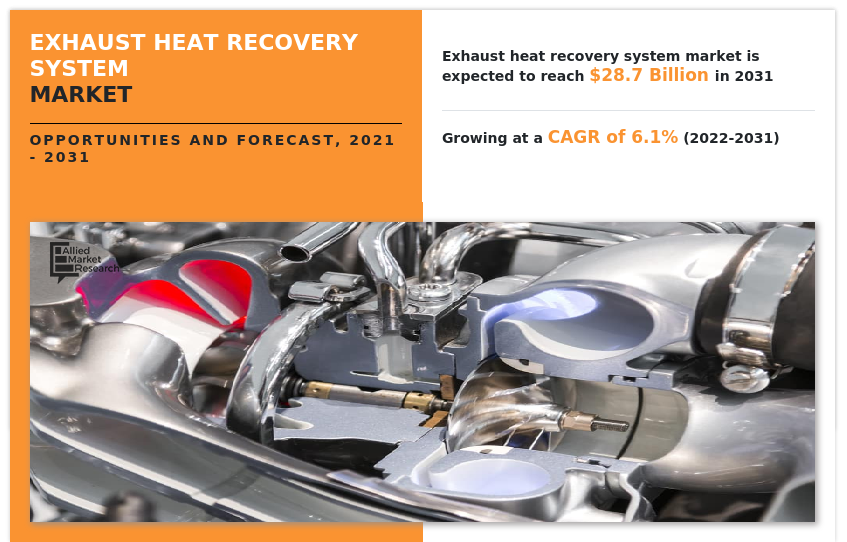
The exhaust heat recovery system market is segmented into Technology, Mode, Vehicle Type and Components.
An exhaust heat recovery system is a technology that utilizes dissipated energy/heat to provide power to the engine and to enhance engine efficiency by recycling exhaust gases. Dissipated energy improves overall performance and minimizes greenhouse gas emissions of the vehicle. An exhaust heat recovery system uses various components such as turbocharger and exhaust gas recirculation system, which have greater penetration in diesel & gasoline powered vehicles.
Factors such as increase in demand for engine performance & fuel efficiency and engine downsizing to reduce vehicle weight are anticipated to boost the growth of the global exhaust heat recovery system market during the forecast period. However, rise in demand for battery electric vehicles and installation issues with exhaust heat recovery systems are expected to hinder the growth of the global market during the forecast period. Moreover, surge in demand for turbochargers and increase in vehicle production in developing countries are projected to create an opportunity for the market in near future.
Exhaust heat recovery system market is segmented on the basis of technology, mode, vehicle type, component, and region. On the basis of technology, it is divided into conventional technology and future technology. By mode, it is divided into exhaust gas recirculation (EGR), turbocharger, organic Rankine cycle, and thermoelectric generator. By vehicle type, it is fragmented into passenger car, light commercial vehicle, truck, and buses. By component, it is divided into EGR component, turbocharger component, organic Rankine cycle component, and thermoelectric generator component. By region, the market is analyzed across North America, Europe, Asia-Pacific, and LAMEA.
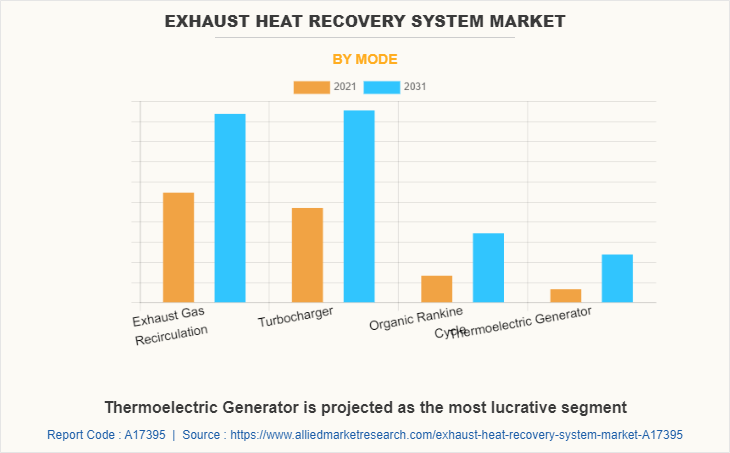
The key players that operate in this exhaust heat recovery system market are Aisin Corporation, Borgwarner Inc., Calsonic Kansei Corporation (Marelli Holdings Co., Ltd.), CDTi Advanced Materials Inc., Continental AG, Dana Limited, Denso Corporation, Eberspächer Gruppe GmbH & Co. KG, Faurecia, Garrett Motion Inc., IHI Corporation, Katcon SA de C.V., MAHLE GmbH, Mitsubishi Heavy Industries, Ltd., Schaeffler AG, Tenneco Inc., and Valeo.
Increase in demand for engine performance and fuel efficiency
Governments all over the world have enforced the use of fuel-efficient vehicles to reduce pollution and the climatic impact of automobiles. For instance, the European Union (EU) has mandated that average fuel efficiency across manufacturer fleets achieve 57 U.S. miles per gallon (mpg) by 2021, up from 41.9 U.S. miles per gallon in 2015, and 92 U.S. miles per gallon by 2030. Increased government measures to improve automobile fuel efficiency have prompted automakers to integrate advance technology into their vehicles to reduce vehicle weight and increase the vehicle efficiency. Performance of vehicle depends upon engine. Hence, vehicle manufacturers are forced to manufacture efficient engines, which can satisfy both the requirements and can deliver improved performance & fuel efficiency at the same time. The exhaust heat recovery solutions such as turbochargers and exhaust gas recirculation system (EGR) are primarily turbo boosted engines that are compact in size and specifically designed to increase fuel efficiency in compliance with the Corporate Average Fuel Economy and Euro VI standards. In addition, these systems offer several advantages, for instance, increased air intake in the combustion chamber, high engine performance, and reuse of exhausted air. Turbochargers particularly work best on high engine speeds and do not require any power source to operate. Hence, improved engine performance and fuel efficiency are considered as the prime drivers for the global exhaust heat recovery system market growth.
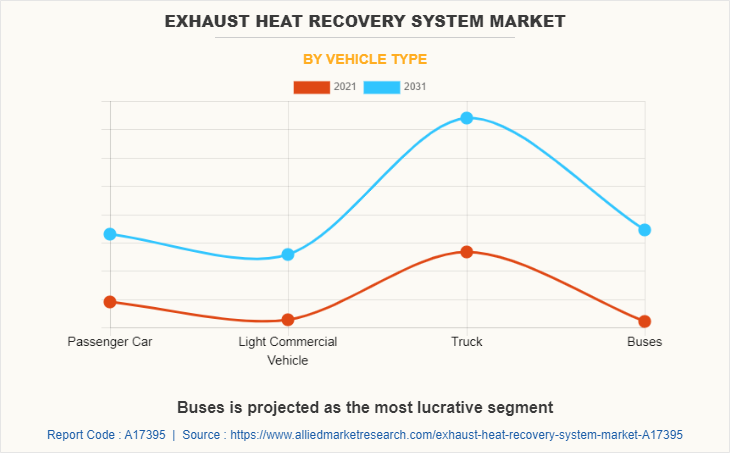
Engine downsizing to reduce vehicle weight
Engine downsizing is the technique of using smaller combustion engines over bigger ones of the same power capacity when manufacturing vehicles in the automotive industry. It is the outcome of automakers' efforts to offer more efficient vehicles with lower emissions, which are frequently enforced by government regulations. Engine downsizing includes reducing the number of cylinders to lower the engine's overall size. By reducing the number of cylinders, the amount of friction in the engine is reduced. Advancements in exhaust heat recovery system technology, such as the use of turbocharger, exhaust gas recirculation, have resulted in a decrease in total engine size while retaining or increasing power output. Moreover, persistent growth of exhaust heat recovery system technology is predominantly driven by heightened demand for vehicle manufacturers to encounter environmental emission regulations. In addition, engine downsizing trend is on a rise, owing to the increasing concern of vehicle weight. Currently, increase in fuel economy standards along with rise in demand for enhanced vehicle performance boost the growth of the turbocharger market. The light weight alloy is used in the manufacturing of turbocharger that further reduces fuel consumption. This is expected to drive the market for exhaust heat recovery system technology.
Increase in demand for battery electric vehicles
The electric vehicles market is growing exponentially, owing to factors such as climate change and efforts to achieve net zero emissions. Moreover, favorable incentives and policies introduced by governments of different countries to promote electric vehicles boost growth of the EV industry. For instance, in 2021, in California, Clean Vehicle Rebate Project (CVRP) promoted clean vehicle adoption in California by offering rebates ranging from $1,000 to $7,000 for purchases or leases of new zero-emission vehicles. In addition, in 2021, New Zealand proposed clean car discount in which new car buyers received a $8,625 rebate for electric vehicles (EVs) less than $80,000, including GST and road costs. Rise in awareness regarding climate change and surge in demand for electric cars lead to increase in production of electric vehicles. For instance, according to a report by the IEA organization, 2022, EV vehicles globally reached 6.7 million units in 2021, a 3.7 million units over 2020, accounting for 4.1% of the market share. In 2020, the electrical percentage of automobile income was about 2.4%, increasing from about 2% in 2019. Moreover, some countries announced policies banning and phasing out gasoline and diesel cars. Such measures taken by various governments encourage automakers and other market players to adopt new electric vehicle trend. For instance, in 2022, Ford Motor plans to invest $20 billion in an effort to expand electrification of its lineup with an investment of 20 billion dollars. The rise in production and sales of electric vehicles hinder the growth of exhaust heat recovery system market as these vehicles are zero emission vehicles and do not require exhaust system.
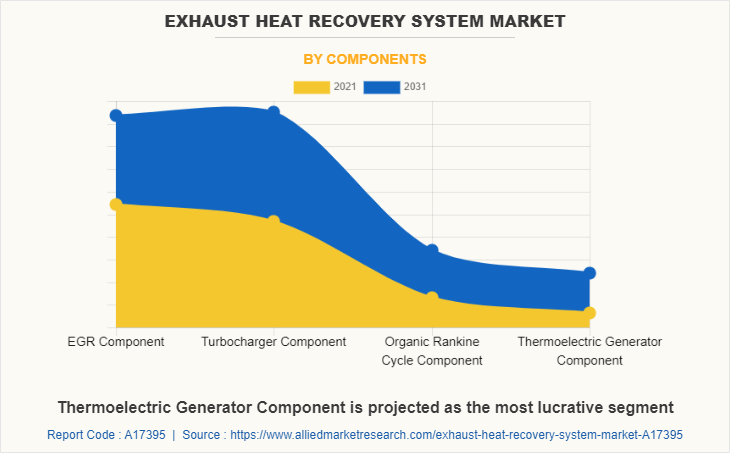
Increase in demand for turbochargers
The exhaust heat recovery system market has a huge growth potential as the industry is full of opportunities due to increase in installation of turbochargers in gasoline engines. Turbocharger is use to compress more air flowing into the engine’s cylinder. When air is compressed the air, molecules are packed closer together. This increase in air means that more fuel can be added for the same size engine. This then generates increased mechanical power and overall efficiency improvement of the combustion process. The majority of the time turbochargers uses the air which is recovered from the exhaust system of the vehicle. Currently, almost all the diesel engine vehicles are equipped with turbocharger technology, unlike their gasoline counterparts. However, in the recent years, turbochargers have found application in gasoline engines as well. In gasoline engines, turbocharging enables downsizing which improves fuel economy by 5-20%. Moreover, electric turbochargers are predicted to be the future of turbocharger technology due to their minimum contribution to environmental pollution. Audi is expected to be among the first automaker to have a production vehicle with an electric turbocharger. The demand and production of vehicles is projected to increase. This works as the major driving force for the turbocharger industry, which in turn is expected to fuel the demand for exhaust gas recovery system during the forecast period.
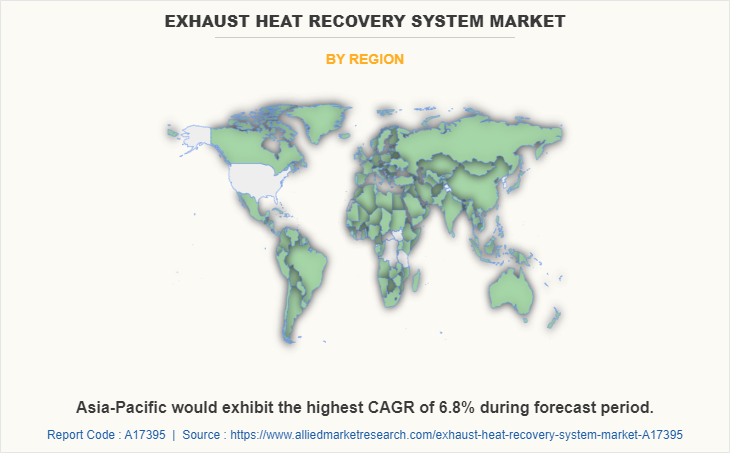
Key Benefits For Stakeholders
- This report provides a quantitative analysis of the market segments, current trends, estimations, and dynamics of the exhaust heat recovery system market analysis from 2021 to 2031 to identify the prevailing exhaust heat recovery system market opportunities.
- The market research is offered along with information related to key drivers, restraints, and opportunities.
- Porter's five forces analysis highlights the potency of buyers and suppliers to enable stakeholders make profit-oriented business decisions and strengthen their supplier-buyer network.
- In-depth analysis of the exhaust heat recovery system market segmentation assists to determine the prevailing market opportunities.
- Major countries in each region are mapped according to their revenue contribution to the global market.
- Market player positioning facilitates benchmarking and provides a clear understanding of the present position of the market players.
- The report includes the analysis of the regional as well as global exhaust heat recovery system market trends, key players, market segments, application areas, and market growth strategies.
Exhaust Heat Recovery System Market Report Highlights
| Aspects | Details |
| By Technology |
|
| By Mode |
|
| By Vehicle Type |
|
| By Components |
|
| By Region |
|
| Key Market Players | VALEO, Mahle, Denso, IHI Corporation, BorgWarner, Dana Inc, Garrett Motion Technology (Shanghai) Co., Ltd., Schaeffler, Continental, Delphi Technologies, Katcon, Clean Diesel Technologies, Calsonic Kansei, MITSUBISHI HEAVY INDUSTRIES, Eberspaecher, Aisin Industries, Tenneco Inc |
Analyst Review
The exhaust heat recovery system market is expected to witness significant growth, due to stringent government regulations related fuel efficiency and vehicle emission. As the global population increases, demand for vehicles grows rapidly. These vehicles run on fossil fuels such as diesel and gasoline. Fuel efficiency is the major concern, owing to presence of limited amount of fuel on earth. Hence, engines need advanced technology to increase their efficiency with minimum fuel consumption. Thus, exhaust gas recovery system is introduced by key manufacturers to cater to this increased demand for fuel efficiency.
Factors such increase in demand for engine performance & fuel efficiency, and engine downsizing to reduce vehicle weight are anticipated to boost the growth of the global exhaust heat recovery system market during the forecast period. However, increase in demand for battery electric vehicles, and installation issues with exhaust heat recovery systems are expected to hinder the growth of the global exhaust heat recovery system market during the forecast period. Moreover, rise in demand for turbochargers and increase in vehicle production in developing countries are expected to create an opportunity for the exhaust heat recovery system market in near future.
To fulfil the change in demand scenarios, market participants have concentrating on product development and product launch strategy to expand their product portfolio and meet new business opportunities. For instance, in October 2020, BorgWarner Inc. upgraded the S410 turbocharger with a renewed design that improves the thermodynamic efficiency through a new rotor and new compressor housing volute for the Mercedes-Benz Novo Actros extra heavy truck. Itprovides better compressor efficiency with reduced air compression temperature and fuel consumption. Moreover, in June 2022, at the 2019 Auto Shanghai, Tenneco Inc. launched its latest engine and exhaust system solutions that address fuel economy, performance, and emissions requirements for China and other markets. In addition, market participants are continuously focusing on partnership strategy to improve product and customer reach. For instance, in March 2021, Tenneco Inc. entered into a partnership with power management company Eaton to produce an integrated exhaust thermal management system that is expected to enable commercial truck and light vehicle manufacturers to meet upcoming emissions regulations.
The key players that operate in this market are Aisin Corporation, Borgwarner Inc., Calsonic Kansei Corporation (Marelli Holdings Co., Ltd.), CDTi Advanced Materials Inc., Continental AG, Dana Limited, Denso Corporation, Eberspächer Gruppe GmbH & Co. KG, Faurecia, Garrett Motion Inc., IHI Corporation, Katcon SA de C.V., MAHLE GmbH, Mitsubishi Heavy Industries, Ltd., Schaeffler AG, Tenneco Inc., and Valeo.
The global exhaust heat recovery system market was valued at $16.1 billion in 2021, and is projected to reach $28.7 billion by 2031, registering a CAGR of 6.1% from 2022 to 2031
Increase in demand for engine performance and fuel efficiency, and engine downsizing to reduce vehicle weight are the upcoming trends of Exhaust Heat Recovery System Market
In 2031, turbocharger is expected to be the leading application of Exhaust Heat Recovery System Market
Asia-Pacific is the largest regional market for Exhaust Heat Recovery System
The key players that operate in this exhaust heat recovery system market are Aisin Corporation, Borgwarner Inc., Calsonic Kansei Corporation (Marelli Holdings Co., Ltd.), CDTi Advanced Materials Inc., Continental AG, Dana Limited, Denso Corporation, Eberspächer Gruppe GmbH & Co. KG, Faurecia, Garrett Motion Inc., IHI Corporation, Katcon SA de C.V., MAHLE GmbH, Mitsubishi Heavy Industries, Ltd., Schaeffler AG, Tenneco Inc., and Valeo
Loading Table Of Content...


